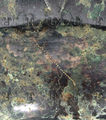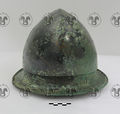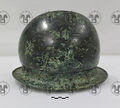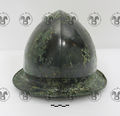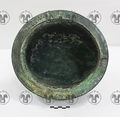SL-1 helmet: Difference between revisions
No edit summary |
|||
| Line 20: | Line 20: | ||
}} | }} | ||
== Commentary == | == Commentary == | ||
Bronze Negau-type helmet of the Slovenian type, variant Vače.<br>Domed bowl with median ridge; highly creased filler with roll-shaped chin strap bails. The filler was riveted together in one place on the back side; the two rivets still visible. Interior brim of the filler perforated at regular intervals. Patina from light green to dark green in colour with patches from light brown to white in colour. Age-related corrosion with some slivers. Rarely other traces of abrasion. Slight dell on the left exterior of the brim thus the brim slightly broken in this area.<br>Stamped decoration around the filler, a row of palmettes and a spiral eyes row between three lines which on the one hand enframed the decoration rows, otherwise the lines serve as border for each row. On exterior no further decoration.<br>In front of the | Bronze Negau-type helmet of the Slovenian type, variant Vače.<br>Domed bowl with median ridge; highly creased filler with roll-shaped chin strap bails. The filler was riveted together in one place on the back side; the two rivets still visible. Interior brim of the filler perforated at regular intervals. Patina from light green to dark green in colour with patches from light brown to white in colour. Age-related corrosion with some slivers. Rarely other traces of abrasion. Slight dell on the left exterior of the brim thus the brim slightly broken in this area.<br>Stamped decoration around the filler, a row of palmettes and a spiral eyes row between three lines which on the one hand enframed the decoration rows, otherwise the lines serve as border for each row. On exterior no further decoration.<br>In front of the chamfer an embossed [[index::SL-1|inscription]], and marks in two more places: An oblique stroke {{c||line d 2}} (height 1.5 cm) is embossed with a pointed tool (about thirty indentations) in the back on the chamfer. The same mark is found in the exact same place on another Negau helmet ([[index::Kunsthistorisches Museum Wien – Antikensammlung]], VI 1668), but embossed with an oblong tool ({{bib|Marstrander 1927}}: 14 f. and 20). Another mark {{c||line d 2}} {{c||line d 1}} (height 0.6 cm) is embossed on the edge of the calotte right over the chamfer and the oblique stroke.<br>An attribution of the helmet to the variant Vače is possible because of the roll-shaped bails which are characteristical of this variant in contrast to the variant Idrija and the for this variant typical bracket bails. Also characteristic of the Vače group is a stamped decoration in form of spiral eyes, circle eyes or palmettes. Normally the Negau helmets of the Slovenian type, variant Vače, were dated to the second half of the 5th century BC. At the turn of the 4th century the variant Idrija appears. For the distinction of the different variants and the dating see {{bib|Urban & Nedoma 2002}}: 52–54.<br>Any indications of the find circumstances like detailed find place are unknown. The helmet was purchased by the [[index::Kunsthistorisches Museum Wien – Antikensammlung|Kunsthistorisches Museum]] from Johann Grilz who excavated the helmet near the location of Klenik, 1866. An attached document – dated to the 10 July 1866 – of the [[index::Kunsthistorisches Museum Wien – Antikensammlung|Kunsthistorisches Museum]] indicates that the helmet was part of a number of antiquities which were sold by Johann Grilz to the museum. But there are no references about the detailed find place ({{bib|Reinecke 1942}}: 145–146). It is however obviously that the helmet must be found before July 1866.<br>Due to the missing find circumstances a specific classification is not possible. The good state of preservation of the helmet at which no evidence of intentional damage are visible implies that the kind of deposition does not suggest a sacral motivation ({{bib|Nedoma 1995}}: 33).<br>Against the good state of preservation of the helmet and the well legible [[index::SL-1|inscription]] in the front of the throat, currently the helmet is preserved in the repository of the [[index::Kunsthistorisches Museum Wien – Antikensammlung|Kunsthistorisches Museum]] due to museum didactic aspects. The showcase which presents all the other Negau helmets is reserved to all the helmets of the hoard of [[index::Ženjak]] e.g. [[index::SL-2 helmet]]. | ||
{{bibliography}} | {{bibliography}} | ||
Revision as of 21:31, 28 March 2014
| Object | |
|---|---|
| Proper name: | Helmet of Vače |
| Classification: | helmet |
| Archaeological type: | Negau helmet, Slovenian type, variant Vače |
| Material: | bronze |
| Size: | height 19.5 cm, diameter min. 25.7 cm, diameter max. 27.9 cm, thickness min. 1.4 mm, thickness max. 2.0 mm |
| Condition: | complete |
| Date: | second half of the 5th century BC |
| Date derived from: | typology |
|
| |
| Site: | Vače (Litija, Slovenia) |
| Coordinates (approx.): | 46° 7' 8.40" N, 14° 50' 16.80" E [from site] |
| Find date: | before July 1866 |
| Find circumstances: | unknown |
| Current location: | Kunsthistorisches Museum Wien – Antikensammlung (repository) |
| Inventory Nr.: | VI 2655 |
|
| |
| Inscription: | SL-1 (terisna) |
|
| |
| Sources: | Reinecke 1942: 145–146 Egg 1986: 228 (No. 330), fig. 186, pl. 249 Nedoma 1995: 32–34, fig. 22, 23 |
Images
|
Object SL-1 helmet - detail rear side.
|
Object SL-1 helmet - detail rear side.
|
Object SL-1 helmet with inscription SL-1 - front side.
|
Object SL-1 helmet - sideview.
|
Object SL-1 helmet - rear side.
|
|
Object SL-1 helmet - underside.
|
Object SL-1 helmet - detail of the brim.
|
Object SL-1 helmet - detail of the brim.
|
Commentary
Bronze Negau-type helmet of the Slovenian type, variant Vače.
Domed bowl with median ridge; highly creased filler with roll-shaped chin strap bails. The filler was riveted together in one place on the back side; the two rivets still visible. Interior brim of the filler perforated at regular intervals. Patina from light green to dark green in colour with patches from light brown to white in colour. Age-related corrosion with some slivers. Rarely other traces of abrasion. Slight dell on the left exterior of the brim thus the brim slightly broken in this area.
Stamped decoration around the filler, a row of palmettes and a spiral eyes row between three lines which on the one hand enframed the decoration rows, otherwise the lines serve as border for each row. On exterior no further decoration.
In front of the chamfer an embossed inscription, and marks in two more places: An oblique stroke ![]() (height 1.5 cm) is embossed with a pointed tool (about thirty indentations) in the back on the chamfer. The same mark is found in the exact same place on another Negau helmet (Kunsthistorisches Museum Wien – Antikensammlung, VI 1668), but embossed with an oblong tool (Marstrander 1927: 14 f. and 20). Another mark
(height 1.5 cm) is embossed with a pointed tool (about thirty indentations) in the back on the chamfer. The same mark is found in the exact same place on another Negau helmet (Kunsthistorisches Museum Wien – Antikensammlung, VI 1668), but embossed with an oblong tool (Marstrander 1927: 14 f. and 20). Another mark ![]()
![]() (height 0.6 cm) is embossed on the edge of the calotte right over the chamfer and the oblique stroke.
(height 0.6 cm) is embossed on the edge of the calotte right over the chamfer and the oblique stroke.
An attribution of the helmet to the variant Vače is possible because of the roll-shaped bails which are characteristical of this variant in contrast to the variant Idrija and the for this variant typical bracket bails. Also characteristic of the Vače group is a stamped decoration in form of spiral eyes, circle eyes or palmettes. Normally the Negau helmets of the Slovenian type, variant Vače, were dated to the second half of the 5th century BC. At the turn of the 4th century the variant Idrija appears. For the distinction of the different variants and the dating see Urban & Nedoma 2002: 52–54.
Any indications of the find circumstances like detailed find place are unknown. The helmet was purchased by the Kunsthistorisches Museum from Johann Grilz who excavated the helmet near the location of Klenik, 1866. An attached document – dated to the 10 July 1866 – of the Kunsthistorisches Museum indicates that the helmet was part of a number of antiquities which were sold by Johann Grilz to the museum. But there are no references about the detailed find place (Reinecke 1942: 145–146). It is however obviously that the helmet must be found before July 1866.
Due to the missing find circumstances a specific classification is not possible. The good state of preservation of the helmet at which no evidence of intentional damage are visible implies that the kind of deposition does not suggest a sacral motivation (Nedoma 1995: 33).
Against the good state of preservation of the helmet and the well legible inscription in the front of the throat, currently the helmet is preserved in the repository of the Kunsthistorisches Museum due to museum didactic aspects. The showcase which presents all the other Negau helmets is reserved to all the helmets of the hoard of Ženjak e.g. SL-2 helmet.
Bibliography
| Egg 1986 | Markus Egg, Italische Helme. Studien zu den ältereisenzeitlichen Helmen Italiens und der Alpen. Teil 1: Text, Teil 2: Tafeln, Mainz: Römisch-Germanisches Zentralmuseum 1986. |
|---|---|
| Marstrander 1927 | Carl Johan Sverdrup Marstrander, "Remarques sur les inscriptions des casques en bronze de Negau et de Watsch", Avhandlinger utgitt av Det Norske Videnskaps-Akademi i Oslo. Hist.-filos. klasse 1926/2 (1927), 1–26. |
